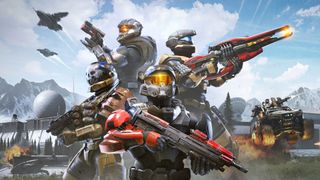
There were a lot of reasons to be nervous going into the first Halo Infinite technical preview. After suffering multiple delays, and following the decision to split the Campaign and Multiplayer components – with multiplayer launching as a free-to-play experience across the Xbox ecosystem – I was beginning to wonder whether 343 Industries was trudging down the long road to ruin. Thankfully, the Halo Infinite beta makes one hell of a good impression.
In our Halo Infinite multiplayer hands-on preview, GamesRadar had the chance to spend the weekend with a two-month old build of the 2021 release to help stress test the servers, test out the new movement and combat mechanics, and try out some new maps and weapons. Suffice to say, I was incredibly impressed with what I played of Halo Infinite. It feels as if 343 Industries and Xbox Game Studios is on the right track to deliver a Halo experience that can hold its own in a highly competitive first-person shooter market, one that delivers the sort of thrills that helped define the series so many years ago all while setting it up for future success and expansion. Here are seven key takeaways from the Halo Infinite technical preview.
1. Movement feels tighter
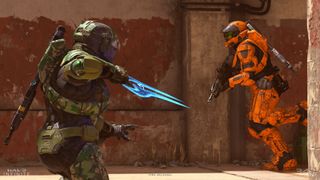
If there's any one area of Halo Infinite's multiplayer design that 343 Industries has to get right from the off, it is movement. Some of the most divisive changes in Halo history came in Guardians, as 343 introduced a raft of 'advanced mobility' mechanics that upended the traditional ebb and flow of multiplayer. For Halo Infinite, the way Spartans handle has been refined. While you're still able to sprint, slide, and clamber, these traversal maneuvers feel tempered – designed to assist you in navigation and positioning, rather than act as central tenets of combat. The removal of ground pound and thruster pack jumps plays a big part in this shift, but overall Halo Infinite feels like it has struck a nice balance between the feel of the Bungie games and 343's desire to bring Halo into the modern era.
2. Combat is aggressive
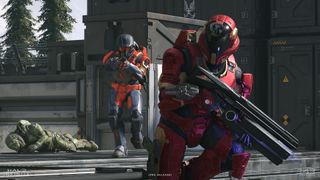
It's hard to believe, but it has been almost six years since Halo 5: Guardians was released. I didn't realize just how much I'd missed playing Halo multiplayer until I sat down with the Halo Infinite technical preview. It's an aggressive game that rewards decisive action and purposeful movement. The Smart Scope mechanic returns – letting you ADS with any weapon – but it feels less effective and intrusive in Halo Infinite, particularly in skirmishes with more than one player. Strafing is key to survival, as is gathering the momentum to unleash devastating melee strikes, and keeping your reticule trained on enemies as they leap around you in the air and circle you on the ground. It's familiar, foundationally, but Halo Infinite is tapping back into a core style of play that helped define Halo: Combat Evolved two decades ago.
3. Classic weapons feel right

If there's one surefire way to know if a Halo game is going to feel right, it's by leaning on a staple of Halo 2 – the "noob combo". The one-two punch of an overcharged Plasma Pistol shot, which used to hone in on encroaching players, completely draining their shield, followed by a quick switch to a precision weapon for the killing blow. It's more satisfying (and tricker) than ever to pull off in Halo Infinite, with the Plasma Pistol requiring significant lead time to land on a moving enemy. Like a lot of the weapons in Halo Infinite, it just feels right. I'm also a big fan of the tweaks made to the starting weapons – the MA40 assault rifle and MK50 Sidekick pistol – which give off big Combat Evolved vibes in their utility, even in the face of some of Halo's more domineering power weapons.
4. Strong core loop
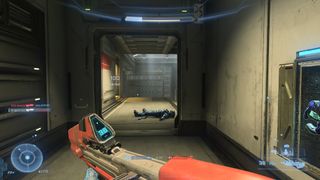
I know plenty of you will be upset that the Battle Rifle has once again been relegated to power status, but as a long-time Halo player that never really vibed with the iconic weapon I'm happy to see the assault rifle return to prominence. Unlike in Halo 5: Guardians, I never felt the need to camp power weapon spawns to get the ineffectual starting guns out of my hands here. Instead, Halo Infinite feels like it has tapped back into the foundational trinity of the series' combat: weapons, grenades, and melee, with the assault rifle at the center of it all. The MA40 is great in close- and mid-range entanglements, particularly when combined with smart grenade placement and the aggressive movement to get within melee striking distance. The core loop of Halo Infinite's multiplayer will feel comfortable to any of you missing the Bungie era.
5. Equipment comes back
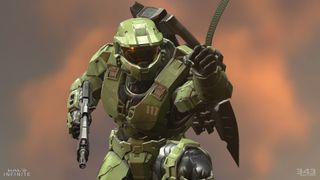
Equipment items have been absent from Master Chief's arsenal since 2007's Halo 3. I knew it was set to make a return for Halo Infinite but I wasn't sure how to feel about it, particularly after learning that 343 Industries was trying to dial into a core arena feel for its multiplayer. After the technical preview, I'm still not entirely sold – although one piece does save it. The Drop Wall is slow to activate and ineffectual, a shadow of the Bubble Shield; the Threat Sensor is a needless pickup, given how active your motion tracker is anyway; thankfully, the Grappleshot makes it all worthwhile. The Grappleshot feels fantastic, regardless of whether you're latching onto, and launching towards, a distant platform or enemy, or using it to steal a power weapon out from under the hands of a camping teammate.
Sign up to the GamesRadar+ Newsletter
Weekly digests, tales from the communities you love, and more
6. Customization is easygoing

When 343 Industries announced that it was taking Halo Infinite free-to-play, there was some obvious concern as to what this would mean for the future of Halo's multiplayer. While battle royales and hero shooters have had no end of success with this method of delivering new items and weapons, it wasn't clear how easily it would be integrated into an ecosystem that has typically thrived through a healthy amount of launch content bolstered by steady DLC releases. 343 offered only a glimpse at how the Battle Pass will function in the Halo Infinite technical preview, but I liked what I saw. Completing challenges for doing every-day activities would help push you through the ranks, unlocking new armor permutations and color schemes. Keeping the Battle Pass centered on customization is shrewd, and reminds me of the way unique armor permutations were tied to collecting skulls, obtaining achievements, and completing Vidmaster challenges for that damned Recon armor back in Halo 3.
7. The maps are solid
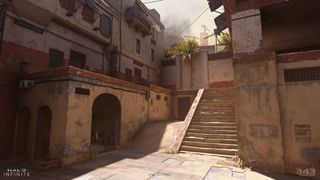
The maps only got better throughout the Halo Infinite technical preview weekend. We started off with Live Fire, a fairly mundane asymmetrical arena that offered little in the way of verticality or variance – better suited to Free-For-All than Team Slayer. Recharge arrived shortly after, offering more opportunities to exploit enemy positioning and better power weapons to play with, but the rotation still felt a little off – a map that would surely excel in objective-based modes. And then there is Bazaar, and what a fantastic little map it is. It felt purpose-built for the four-versus-four chaos that only Halo can produce, a map that gives me faith that 343 could deliver something to the quality of iconic arena maps such as Hang 'Em High, Lockout, or Guardian in Halo Infinite. Here's hoping that the next Halo Infinite technical preview will give us a look at some of the larger, vehicle-equipped maps.
While you're waiting for Halo Infinite to launch later this year, why not check out some of the best Xbox Series X games that are available to play right now.

Josh West is the Editor-in-Chief of GamesRadar+. He has over 15 years experience in online and print journalism, and holds a BA (Hons) in Journalism and Feature Writing. Prior to starting his current position, Josh has served as GR+'s Features Editor and Deputy Editor of games™ magazine, and has freelanced for numerous publications including 3D Artist, Edge magazine, iCreate, Metal Hammer, Play, Retro Gamer, and SFX. Additionally, he has appeared on the BBC and ITV to provide expert comment, written for Scholastic books, edited a book for Hachette, and worked as the Assistant Producer of the Future Games Show. In his spare time, Josh likes to play bass guitar and video games. Years ago, he was in a few movies and TV shows that you've definitely seen but will never be able to spot him in.
Most Popular
